BIZ201 Accounting: Financial Statement Analysis for Decision Making
VerifiedAdded on 2023/06/08
|9
|2181
|341
Case Study
AI Summary
This case study provides a comprehensive analysis of Crystal Hotel Pty Ltd's financial statements, focusing on key areas such as vertical income statement analysis, ratio analysis, and industry benchmark comparisons. The analysis assesses the company's financial health, profitability, efficiency, liquidity, and solvency, comparing its performance against industry averages. The study identifies strengths, such as higher room revenue and lower personnel costs compared to benchmarks, and areas for improvement, particularly in cost of sales and accounts receivable collection. Recommendations include controlling cost of sales and balancing the capital structure. Additional industry benchmark techniques, such as graphical and horizontal analysis, are also discussed. This document is available on Desklib, a platform offering a range of study tools and resources for students.
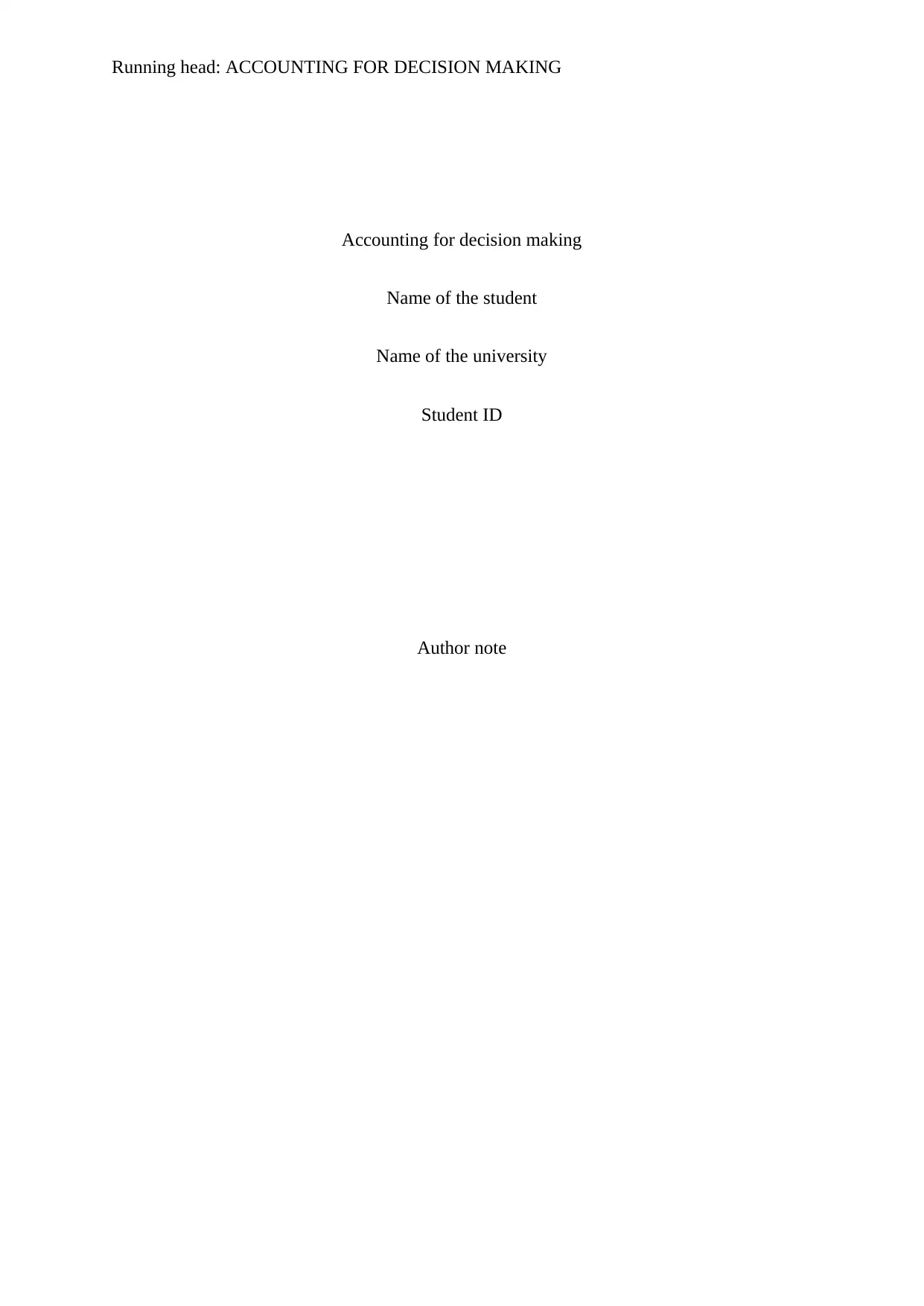
Running head: ACCOUNTING FOR DECISION MAKING
Accounting for decision making
Name of the student
Name of the university
Student ID
Author note
Accounting for decision making
Name of the student
Name of the university
Student ID
Author note
Paraphrase This Document
Need a fresh take? Get an instant paraphrase of this document with our AI Paraphraser

1ACCOUNTING FOR DECISION MAKING
Table of Contents
Analysis of information included in general purpose financial statement.................................2
Analysis of vertical income statement.......................................................................................2
Ratio analysis.............................................................................................................................3
Additional industry benchmark techniques................................................................................5
Reference....................................................................................................................................7
Table of Contents
Analysis of information included in general purpose financial statement.................................2
Analysis of vertical income statement.......................................................................................2
Ratio analysis.............................................................................................................................3
Additional industry benchmark techniques................................................................................5
Reference....................................................................................................................................7
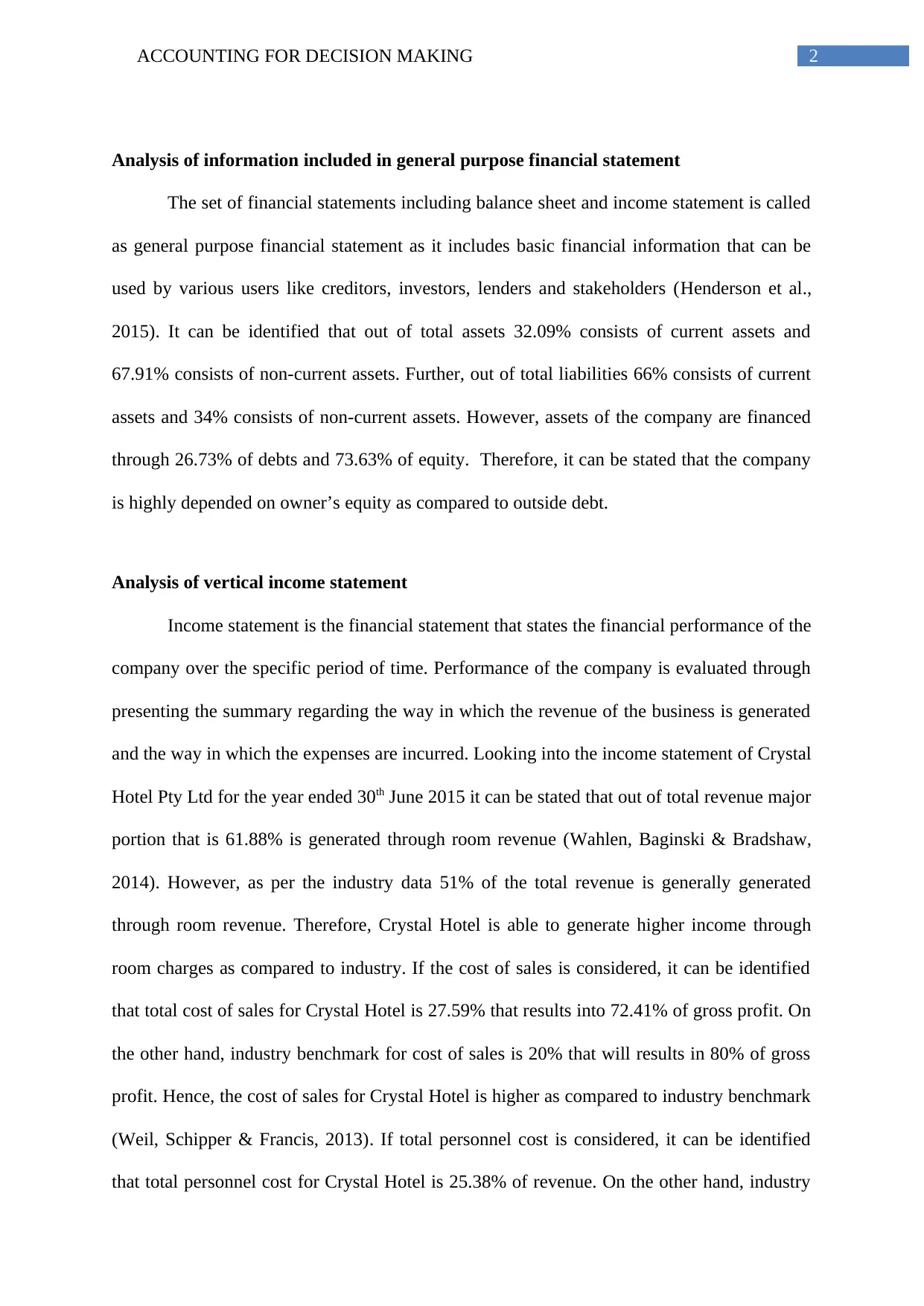
2ACCOUNTING FOR DECISION MAKING
Analysis of information included in general purpose financial statement
The set of financial statements including balance sheet and income statement is called
as general purpose financial statement as it includes basic financial information that can be
used by various users like creditors, investors, lenders and stakeholders (Henderson et al.,
2015). It can be identified that out of total assets 32.09% consists of current assets and
67.91% consists of non-current assets. Further, out of total liabilities 66% consists of current
assets and 34% consists of non-current assets. However, assets of the company are financed
through 26.73% of debts and 73.63% of equity. Therefore, it can be stated that the company
is highly depended on owner’s equity as compared to outside debt.
Analysis of vertical income statement
Income statement is the financial statement that states the financial performance of the
company over the specific period of time. Performance of the company is evaluated through
presenting the summary regarding the way in which the revenue of the business is generated
and the way in which the expenses are incurred. Looking into the income statement of Crystal
Hotel Pty Ltd for the year ended 30th June 2015 it can be stated that out of total revenue major
portion that is 61.88% is generated through room revenue (Wahlen, Baginski & Bradshaw,
2014). However, as per the industry data 51% of the total revenue is generally generated
through room revenue. Therefore, Crystal Hotel is able to generate higher income through
room charges as compared to industry. If the cost of sales is considered, it can be identified
that total cost of sales for Crystal Hotel is 27.59% that results into 72.41% of gross profit. On
the other hand, industry benchmark for cost of sales is 20% that will results in 80% of gross
profit. Hence, the cost of sales for Crystal Hotel is higher as compared to industry benchmark
(Weil, Schipper & Francis, 2013). If total personnel cost is considered, it can be identified
that total personnel cost for Crystal Hotel is 25.38% of revenue. On the other hand, industry
Analysis of information included in general purpose financial statement
The set of financial statements including balance sheet and income statement is called
as general purpose financial statement as it includes basic financial information that can be
used by various users like creditors, investors, lenders and stakeholders (Henderson et al.,
2015). It can be identified that out of total assets 32.09% consists of current assets and
67.91% consists of non-current assets. Further, out of total liabilities 66% consists of current
assets and 34% consists of non-current assets. However, assets of the company are financed
through 26.73% of debts and 73.63% of equity. Therefore, it can be stated that the company
is highly depended on owner’s equity as compared to outside debt.
Analysis of vertical income statement
Income statement is the financial statement that states the financial performance of the
company over the specific period of time. Performance of the company is evaluated through
presenting the summary regarding the way in which the revenue of the business is generated
and the way in which the expenses are incurred. Looking into the income statement of Crystal
Hotel Pty Ltd for the year ended 30th June 2015 it can be stated that out of total revenue major
portion that is 61.88% is generated through room revenue (Wahlen, Baginski & Bradshaw,
2014). However, as per the industry data 51% of the total revenue is generally generated
through room revenue. Therefore, Crystal Hotel is able to generate higher income through
room charges as compared to industry. If the cost of sales is considered, it can be identified
that total cost of sales for Crystal Hotel is 27.59% that results into 72.41% of gross profit. On
the other hand, industry benchmark for cost of sales is 20% that will results in 80% of gross
profit. Hence, the cost of sales for Crystal Hotel is higher as compared to industry benchmark
(Weil, Schipper & Francis, 2013). If total personnel cost is considered, it can be identified
that total personnel cost for Crystal Hotel is 25.38% of revenue. On the other hand, industry
⊘ This is a preview!⊘
Do you want full access?
Subscribe today to unlock all pages.

Trusted by 1+ million students worldwide
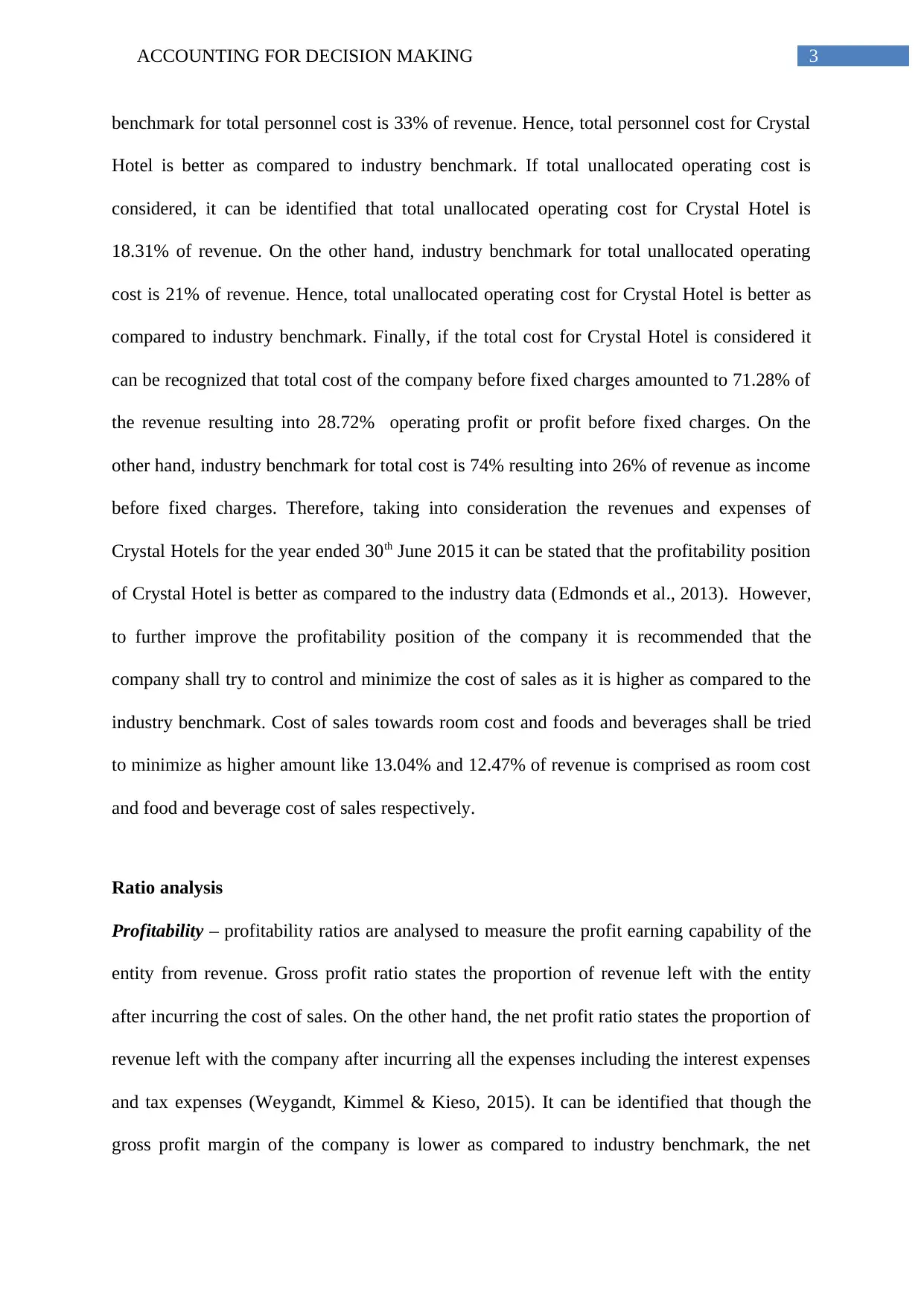
3ACCOUNTING FOR DECISION MAKING
benchmark for total personnel cost is 33% of revenue. Hence, total personnel cost for Crystal
Hotel is better as compared to industry benchmark. If total unallocated operating cost is
considered, it can be identified that total unallocated operating cost for Crystal Hotel is
18.31% of revenue. On the other hand, industry benchmark for total unallocated operating
cost is 21% of revenue. Hence, total unallocated operating cost for Crystal Hotel is better as
compared to industry benchmark. Finally, if the total cost for Crystal Hotel is considered it
can be recognized that total cost of the company before fixed charges amounted to 71.28% of
the revenue resulting into 28.72% operating profit or profit before fixed charges. On the
other hand, industry benchmark for total cost is 74% resulting into 26% of revenue as income
before fixed charges. Therefore, taking into consideration the revenues and expenses of
Crystal Hotels for the year ended 30th June 2015 it can be stated that the profitability position
of Crystal Hotel is better as compared to the industry data (Edmonds et al., 2013). However,
to further improve the profitability position of the company it is recommended that the
company shall try to control and minimize the cost of sales as it is higher as compared to the
industry benchmark. Cost of sales towards room cost and foods and beverages shall be tried
to minimize as higher amount like 13.04% and 12.47% of revenue is comprised as room cost
and food and beverage cost of sales respectively.
Ratio analysis
Profitability – profitability ratios are analysed to measure the profit earning capability of the
entity from revenue. Gross profit ratio states the proportion of revenue left with the entity
after incurring the cost of sales. On the other hand, the net profit ratio states the proportion of
revenue left with the company after incurring all the expenses including the interest expenses
and tax expenses (Weygandt, Kimmel & Kieso, 2015). It can be identified that though the
gross profit margin of the company is lower as compared to industry benchmark, the net
benchmark for total personnel cost is 33% of revenue. Hence, total personnel cost for Crystal
Hotel is better as compared to industry benchmark. If total unallocated operating cost is
considered, it can be identified that total unallocated operating cost for Crystal Hotel is
18.31% of revenue. On the other hand, industry benchmark for total unallocated operating
cost is 21% of revenue. Hence, total unallocated operating cost for Crystal Hotel is better as
compared to industry benchmark. Finally, if the total cost for Crystal Hotel is considered it
can be recognized that total cost of the company before fixed charges amounted to 71.28% of
the revenue resulting into 28.72% operating profit or profit before fixed charges. On the
other hand, industry benchmark for total cost is 74% resulting into 26% of revenue as income
before fixed charges. Therefore, taking into consideration the revenues and expenses of
Crystal Hotels for the year ended 30th June 2015 it can be stated that the profitability position
of Crystal Hotel is better as compared to the industry data (Edmonds et al., 2013). However,
to further improve the profitability position of the company it is recommended that the
company shall try to control and minimize the cost of sales as it is higher as compared to the
industry benchmark. Cost of sales towards room cost and foods and beverages shall be tried
to minimize as higher amount like 13.04% and 12.47% of revenue is comprised as room cost
and food and beverage cost of sales respectively.
Ratio analysis
Profitability – profitability ratios are analysed to measure the profit earning capability of the
entity from revenue. Gross profit ratio states the proportion of revenue left with the entity
after incurring the cost of sales. On the other hand, the net profit ratio states the proportion of
revenue left with the company after incurring all the expenses including the interest expenses
and tax expenses (Weygandt, Kimmel & Kieso, 2015). It can be identified that though the
gross profit margin of the company is lower as compared to industry benchmark, the net
Paraphrase This Document
Need a fresh take? Get an instant paraphrase of this document with our AI Paraphraser
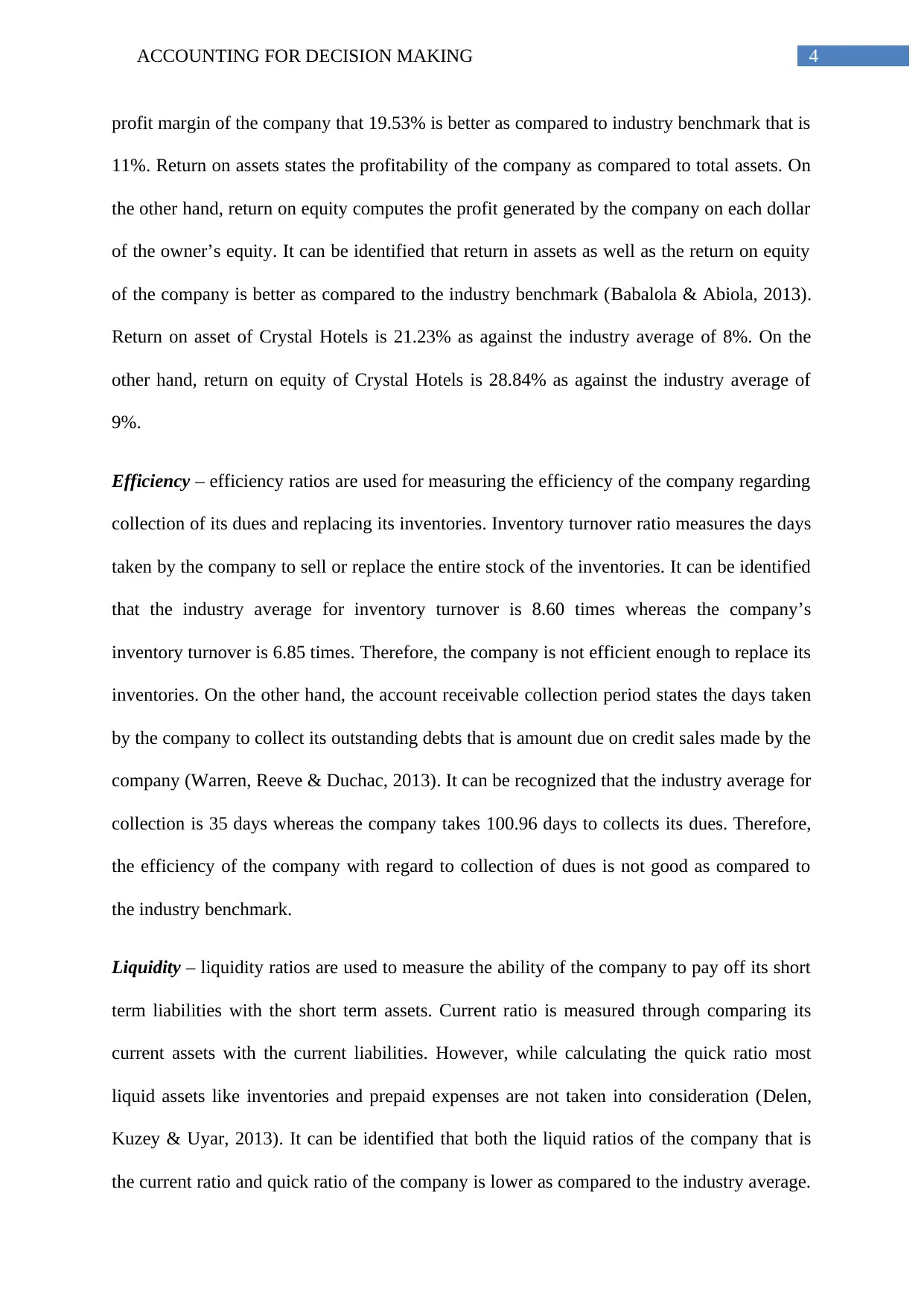
4ACCOUNTING FOR DECISION MAKING
profit margin of the company that 19.53% is better as compared to industry benchmark that is
11%. Return on assets states the profitability of the company as compared to total assets. On
the other hand, return on equity computes the profit generated by the company on each dollar
of the owner’s equity. It can be identified that return in assets as well as the return on equity
of the company is better as compared to the industry benchmark (Babalola & Abiola, 2013).
Return on asset of Crystal Hotels is 21.23% as against the industry average of 8%. On the
other hand, return on equity of Crystal Hotels is 28.84% as against the industry average of
9%.
Efficiency – efficiency ratios are used for measuring the efficiency of the company regarding
collection of its dues and replacing its inventories. Inventory turnover ratio measures the days
taken by the company to sell or replace the entire stock of the inventories. It can be identified
that the industry average for inventory turnover is 8.60 times whereas the company’s
inventory turnover is 6.85 times. Therefore, the company is not efficient enough to replace its
inventories. On the other hand, the account receivable collection period states the days taken
by the company to collect its outstanding debts that is amount due on credit sales made by the
company (Warren, Reeve & Duchac, 2013). It can be recognized that the industry average for
collection is 35 days whereas the company takes 100.96 days to collects its dues. Therefore,
the efficiency of the company with regard to collection of dues is not good as compared to
the industry benchmark.
Liquidity – liquidity ratios are used to measure the ability of the company to pay off its short
term liabilities with the short term assets. Current ratio is measured through comparing its
current assets with the current liabilities. However, while calculating the quick ratio most
liquid assets like inventories and prepaid expenses are not taken into consideration (Delen,
Kuzey & Uyar, 2013). It can be identified that both the liquid ratios of the company that is
the current ratio and quick ratio of the company is lower as compared to the industry average.
profit margin of the company that 19.53% is better as compared to industry benchmark that is
11%. Return on assets states the profitability of the company as compared to total assets. On
the other hand, return on equity computes the profit generated by the company on each dollar
of the owner’s equity. It can be identified that return in assets as well as the return on equity
of the company is better as compared to the industry benchmark (Babalola & Abiola, 2013).
Return on asset of Crystal Hotels is 21.23% as against the industry average of 8%. On the
other hand, return on equity of Crystal Hotels is 28.84% as against the industry average of
9%.
Efficiency – efficiency ratios are used for measuring the efficiency of the company regarding
collection of its dues and replacing its inventories. Inventory turnover ratio measures the days
taken by the company to sell or replace the entire stock of the inventories. It can be identified
that the industry average for inventory turnover is 8.60 times whereas the company’s
inventory turnover is 6.85 times. Therefore, the company is not efficient enough to replace its
inventories. On the other hand, the account receivable collection period states the days taken
by the company to collect its outstanding debts that is amount due on credit sales made by the
company (Warren, Reeve & Duchac, 2013). It can be recognized that the industry average for
collection is 35 days whereas the company takes 100.96 days to collects its dues. Therefore,
the efficiency of the company with regard to collection of dues is not good as compared to
the industry benchmark.
Liquidity – liquidity ratios are used to measure the ability of the company to pay off its short
term liabilities with the short term assets. Current ratio is measured through comparing its
current assets with the current liabilities. However, while calculating the quick ratio most
liquid assets like inventories and prepaid expenses are not taken into consideration (Delen,
Kuzey & Uyar, 2013). It can be identified that both the liquid ratios of the company that is
the current ratio and quick ratio of the company is lower as compared to the industry average.
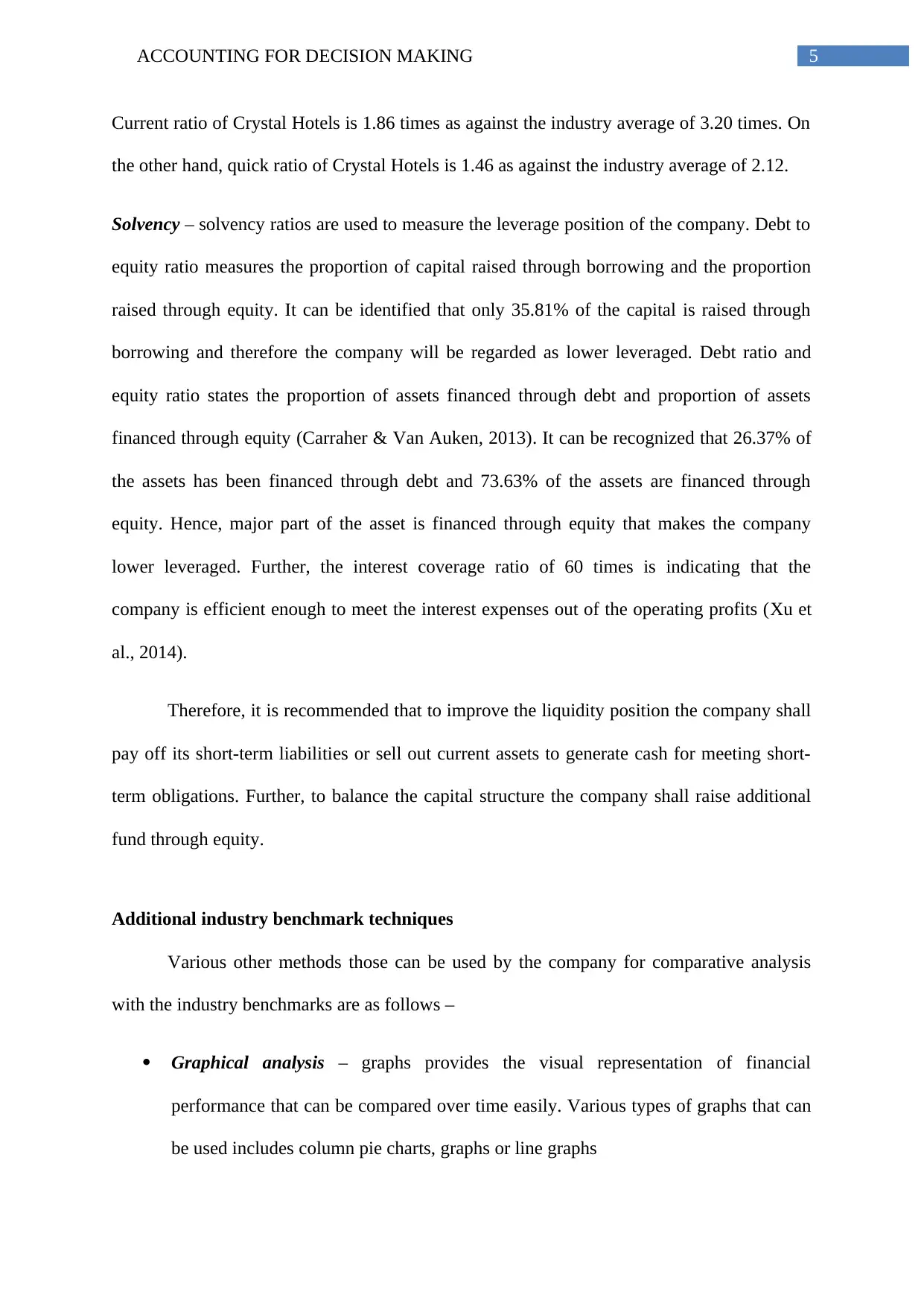
5ACCOUNTING FOR DECISION MAKING
Current ratio of Crystal Hotels is 1.86 times as against the industry average of 3.20 times. On
the other hand, quick ratio of Crystal Hotels is 1.46 as against the industry average of 2.12.
Solvency – solvency ratios are used to measure the leverage position of the company. Debt to
equity ratio measures the proportion of capital raised through borrowing and the proportion
raised through equity. It can be identified that only 35.81% of the capital is raised through
borrowing and therefore the company will be regarded as lower leveraged. Debt ratio and
equity ratio states the proportion of assets financed through debt and proportion of assets
financed through equity (Carraher & Van Auken, 2013). It can be recognized that 26.37% of
the assets has been financed through debt and 73.63% of the assets are financed through
equity. Hence, major part of the asset is financed through equity that makes the company
lower leveraged. Further, the interest coverage ratio of 60 times is indicating that the
company is efficient enough to meet the interest expenses out of the operating profits (Xu et
al., 2014).
Therefore, it is recommended that to improve the liquidity position the company shall
pay off its short-term liabilities or sell out current assets to generate cash for meeting short-
term obligations. Further, to balance the capital structure the company shall raise additional
fund through equity.
Additional industry benchmark techniques
Various other methods those can be used by the company for comparative analysis
with the industry benchmarks are as follows –
Graphical analysis – graphs provides the visual representation of financial
performance that can be compared over time easily. Various types of graphs that can
be used includes column pie charts, graphs or line graphs
Current ratio of Crystal Hotels is 1.86 times as against the industry average of 3.20 times. On
the other hand, quick ratio of Crystal Hotels is 1.46 as against the industry average of 2.12.
Solvency – solvency ratios are used to measure the leverage position of the company. Debt to
equity ratio measures the proportion of capital raised through borrowing and the proportion
raised through equity. It can be identified that only 35.81% of the capital is raised through
borrowing and therefore the company will be regarded as lower leveraged. Debt ratio and
equity ratio states the proportion of assets financed through debt and proportion of assets
financed through equity (Carraher & Van Auken, 2013). It can be recognized that 26.37% of
the assets has been financed through debt and 73.63% of the assets are financed through
equity. Hence, major part of the asset is financed through equity that makes the company
lower leveraged. Further, the interest coverage ratio of 60 times is indicating that the
company is efficient enough to meet the interest expenses out of the operating profits (Xu et
al., 2014).
Therefore, it is recommended that to improve the liquidity position the company shall
pay off its short-term liabilities or sell out current assets to generate cash for meeting short-
term obligations. Further, to balance the capital structure the company shall raise additional
fund through equity.
Additional industry benchmark techniques
Various other methods those can be used by the company for comparative analysis
with the industry benchmarks are as follows –
Graphical analysis – graphs provides the visual representation of financial
performance that can be compared over time easily. Various types of graphs that can
be used includes column pie charts, graphs or line graphs
⊘ This is a preview!⊘
Do you want full access?
Subscribe today to unlock all pages.

Trusted by 1+ million students worldwide
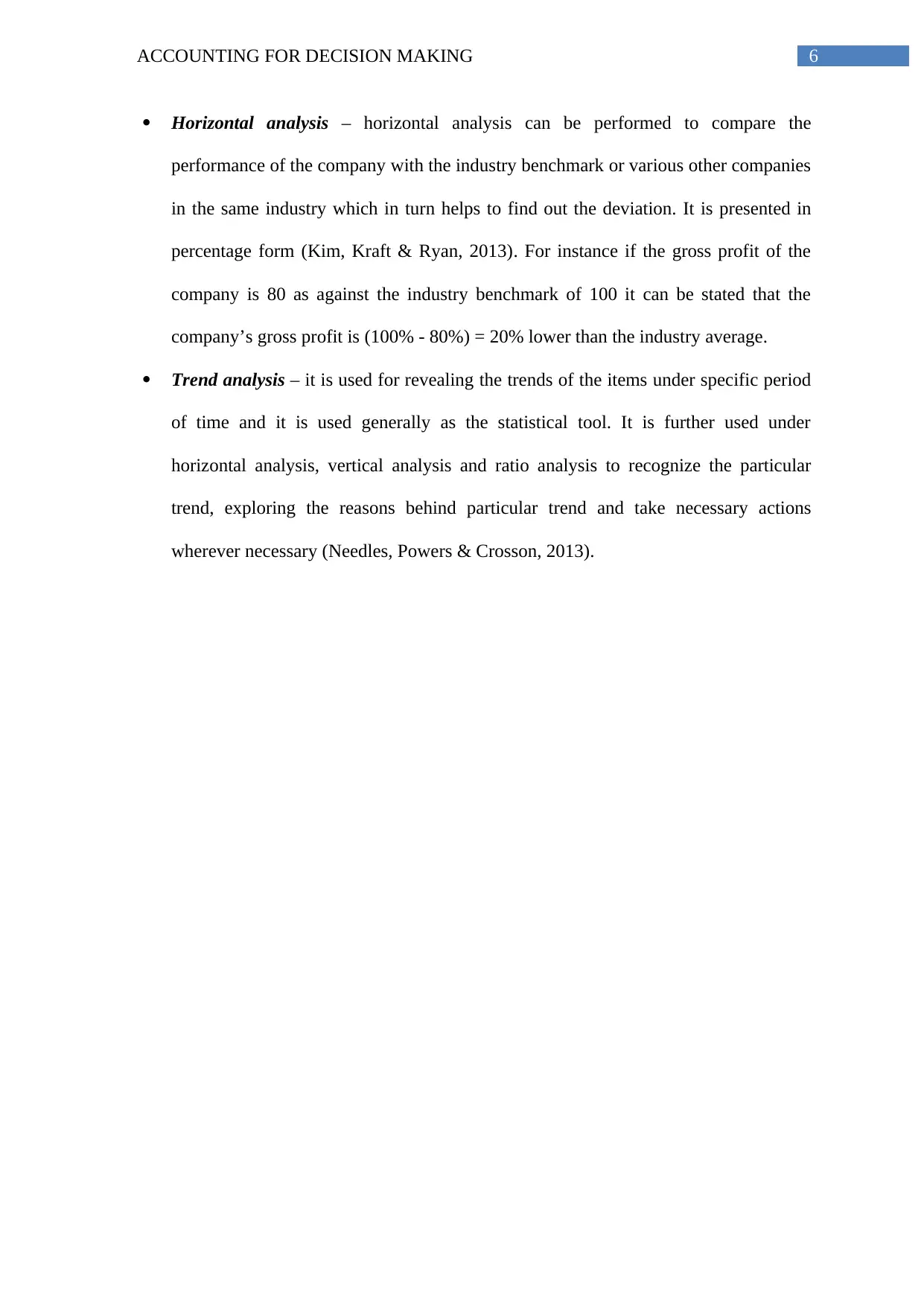
6ACCOUNTING FOR DECISION MAKING
Horizontal analysis – horizontal analysis can be performed to compare the
performance of the company with the industry benchmark or various other companies
in the same industry which in turn helps to find out the deviation. It is presented in
percentage form (Kim, Kraft & Ryan, 2013). For instance if the gross profit of the
company is 80 as against the industry benchmark of 100 it can be stated that the
company’s gross profit is (100% - 80%) = 20% lower than the industry average.
Trend analysis – it is used for revealing the trends of the items under specific period
of time and it is used generally as the statistical tool. It is further used under
horizontal analysis, vertical analysis and ratio analysis to recognize the particular
trend, exploring the reasons behind particular trend and take necessary actions
wherever necessary (Needles, Powers & Crosson, 2013).
Horizontal analysis – horizontal analysis can be performed to compare the
performance of the company with the industry benchmark or various other companies
in the same industry which in turn helps to find out the deviation. It is presented in
percentage form (Kim, Kraft & Ryan, 2013). For instance if the gross profit of the
company is 80 as against the industry benchmark of 100 it can be stated that the
company’s gross profit is (100% - 80%) = 20% lower than the industry average.
Trend analysis – it is used for revealing the trends of the items under specific period
of time and it is used generally as the statistical tool. It is further used under
horizontal analysis, vertical analysis and ratio analysis to recognize the particular
trend, exploring the reasons behind particular trend and take necessary actions
wherever necessary (Needles, Powers & Crosson, 2013).
Paraphrase This Document
Need a fresh take? Get an instant paraphrase of this document with our AI Paraphraser
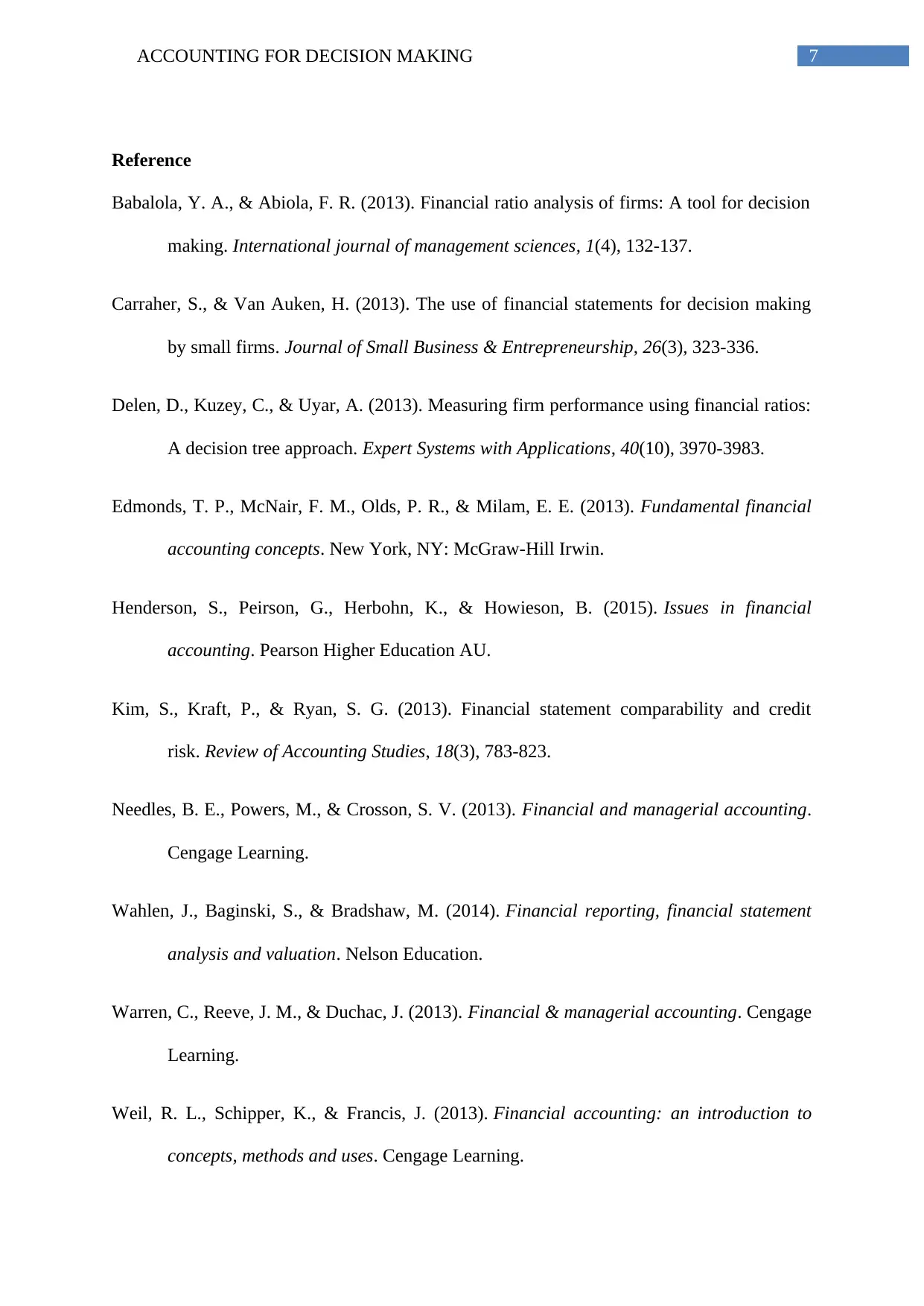
7ACCOUNTING FOR DECISION MAKING
Reference
Babalola, Y. A., & Abiola, F. R. (2013). Financial ratio analysis of firms: A tool for decision
making. International journal of management sciences, 1(4), 132-137.
Carraher, S., & Van Auken, H. (2013). The use of financial statements for decision making
by small firms. Journal of Small Business & Entrepreneurship, 26(3), 323-336.
Delen, D., Kuzey, C., & Uyar, A. (2013). Measuring firm performance using financial ratios:
A decision tree approach. Expert Systems with Applications, 40(10), 3970-3983.
Edmonds, T. P., McNair, F. M., Olds, P. R., & Milam, E. E. (2013). Fundamental financial
accounting concepts. New York, NY: McGraw-Hill Irwin.
Henderson, S., Peirson, G., Herbohn, K., & Howieson, B. (2015). Issues in financial
accounting. Pearson Higher Education AU.
Kim, S., Kraft, P., & Ryan, S. G. (2013). Financial statement comparability and credit
risk. Review of Accounting Studies, 18(3), 783-823.
Needles, B. E., Powers, M., & Crosson, S. V. (2013). Financial and managerial accounting.
Cengage Learning.
Wahlen, J., Baginski, S., & Bradshaw, M. (2014). Financial reporting, financial statement
analysis and valuation. Nelson Education.
Warren, C., Reeve, J. M., & Duchac, J. (2013). Financial & managerial accounting. Cengage
Learning.
Weil, R. L., Schipper, K., & Francis, J. (2013). Financial accounting: an introduction to
concepts, methods and uses. Cengage Learning.
Reference
Babalola, Y. A., & Abiola, F. R. (2013). Financial ratio analysis of firms: A tool for decision
making. International journal of management sciences, 1(4), 132-137.
Carraher, S., & Van Auken, H. (2013). The use of financial statements for decision making
by small firms. Journal of Small Business & Entrepreneurship, 26(3), 323-336.
Delen, D., Kuzey, C., & Uyar, A. (2013). Measuring firm performance using financial ratios:
A decision tree approach. Expert Systems with Applications, 40(10), 3970-3983.
Edmonds, T. P., McNair, F. M., Olds, P. R., & Milam, E. E. (2013). Fundamental financial
accounting concepts. New York, NY: McGraw-Hill Irwin.
Henderson, S., Peirson, G., Herbohn, K., & Howieson, B. (2015). Issues in financial
accounting. Pearson Higher Education AU.
Kim, S., Kraft, P., & Ryan, S. G. (2013). Financial statement comparability and credit
risk. Review of Accounting Studies, 18(3), 783-823.
Needles, B. E., Powers, M., & Crosson, S. V. (2013). Financial and managerial accounting.
Cengage Learning.
Wahlen, J., Baginski, S., & Bradshaw, M. (2014). Financial reporting, financial statement
analysis and valuation. Nelson Education.
Warren, C., Reeve, J. M., & Duchac, J. (2013). Financial & managerial accounting. Cengage
Learning.
Weil, R. L., Schipper, K., & Francis, J. (2013). Financial accounting: an introduction to
concepts, methods and uses. Cengage Learning.
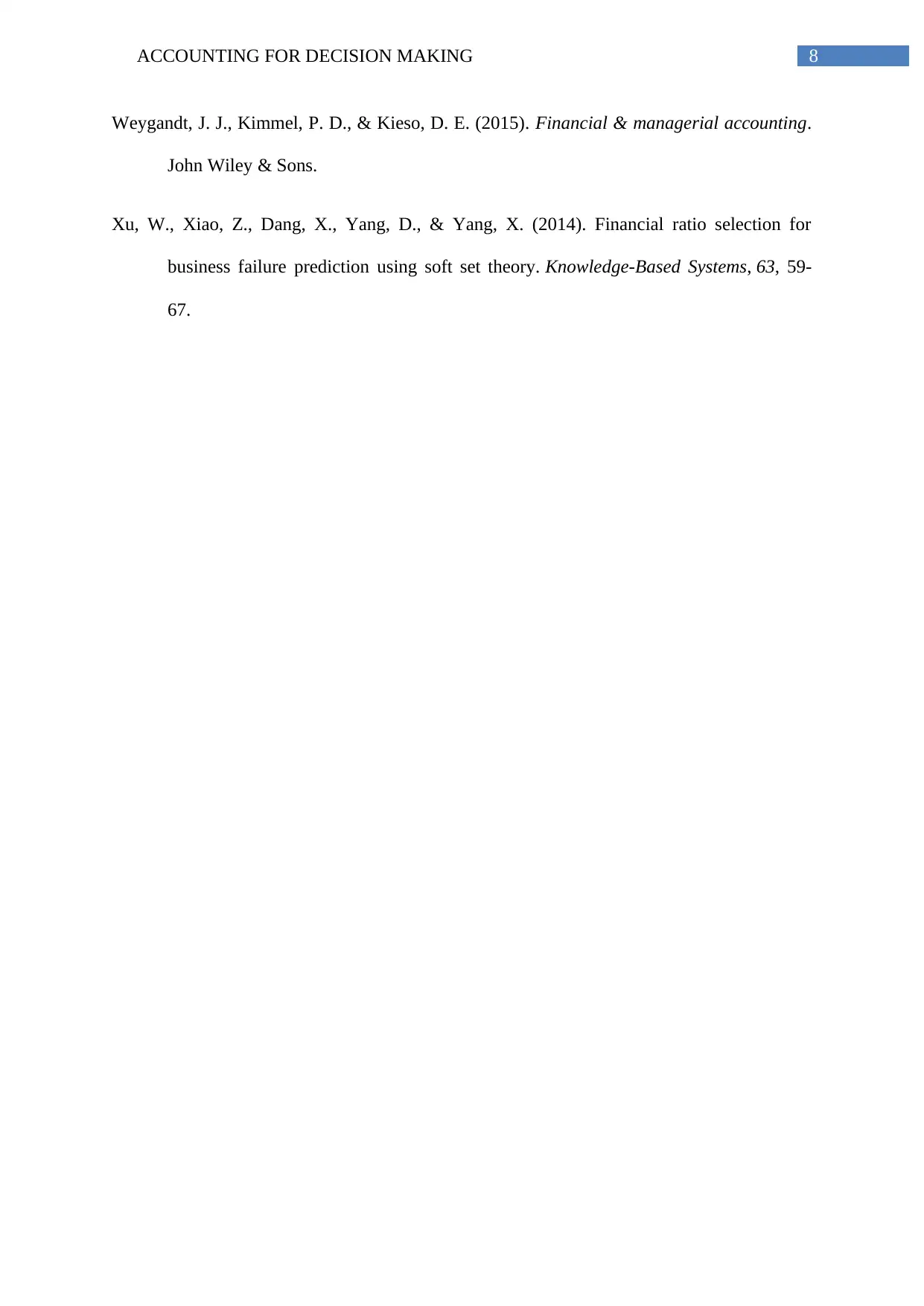
8ACCOUNTING FOR DECISION MAKING
Weygandt, J. J., Kimmel, P. D., & Kieso, D. E. (2015). Financial & managerial accounting.
John Wiley & Sons.
Xu, W., Xiao, Z., Dang, X., Yang, D., & Yang, X. (2014). Financial ratio selection for
business failure prediction using soft set theory. Knowledge-Based Systems, 63, 59-
67.
Weygandt, J. J., Kimmel, P. D., & Kieso, D. E. (2015). Financial & managerial accounting.
John Wiley & Sons.
Xu, W., Xiao, Z., Dang, X., Yang, D., & Yang, X. (2014). Financial ratio selection for
business failure prediction using soft set theory. Knowledge-Based Systems, 63, 59-
67.
⊘ This is a preview!⊘
Do you want full access?
Subscribe today to unlock all pages.

Trusted by 1+ million students worldwide
1 out of 9
Related Documents
Your All-in-One AI-Powered Toolkit for Academic Success.
+13062052269
info@desklib.com
Available 24*7 on WhatsApp / Email
![[object Object]](/_next/static/media/star-bottom.7253800d.svg)
Unlock your academic potential
Copyright © 2020–2025 A2Z Services. All Rights Reserved. Developed and managed by ZUCOL.




